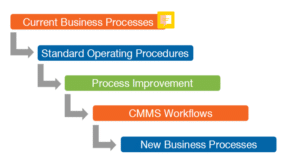
No matter how large or small your operation, a computerized maintenance management system (CMMS) is an enabling tool that turns your maintenance needs into real-time practices.
A CMMS collects and stores asset data, work orders, materials and inventory, and other key asset management information in one place. It can help transform the productivity of your maintenance team by:
- Automating workflows and processes
- Tracking work, including the time required for project completion and the associated costs
- Managing MRO levels
- Ensuring compliance with industry or government regulations
- Producing empirical asset health data that allows maintenance priorities to be set and decisions to be driven by evidence
- Providing the technological prowess to ensure that capacity assurance is attainable and then sustainable
Sounds great, right?
Indeed. But experts estimate that up to 70 percent of initial CMMS implementations fail to meet expectations. That’s why we’ve written a detailed white paper that outlines 10 key steps that can help ensure success:
- Select a project champion and a cross-functional implementation team
Identify a central owner who understands that capacity assurance is a process of continuous improvement—not just a one-time project. Your champion should choose a supporting team that draws expertise from a variety of departments, ranging from information technology to purchasing to materials management. Consider tapping software developers and other consultants as well. - Familiarize the core team with the CMMS
The core team comprises your CMMS experts and future trainers. Your software developer or other consultants should provide hands-on training to bring members up to speed and ensure its capabilities are fully understood and used successfully. - Define workflow processes

- Invest time in standard operating procedures (SOPs)
Make sure you document all of the processes captured in SOPs. Likewise, assets should be classified and grouped by type (pumps, generators, etc.), ordered in hierarchies, and defined by location and criticality. You also will need to determine asset tracking levels; assign appropriate codes to items, problems, and costs; specify the person responsible for each procedure, and identify the tasks required for maintenance and the tools and materials needed. Avoid falling into the trap of thinking that SOPs don’t have to be written down; failures occur when procedures aren’t clearly defined. - Prioritize your implementation
Establish the processes you want to automate first, starting with the “low-hanging fruit,” and commit to a timeline. A series of quick wins will give your entire team confidence and build support within the organization. Focus only on collecting the data you know you’ll need; ancillary information can always be gathered later. Leverage the experience of a seasoned CMMS implementer for guidance.
Get all 10 tips in our informative white paper, “What’s the Secret to CMMS?” It is designed to help you implement a CMMS at your company. Download the white paper.

